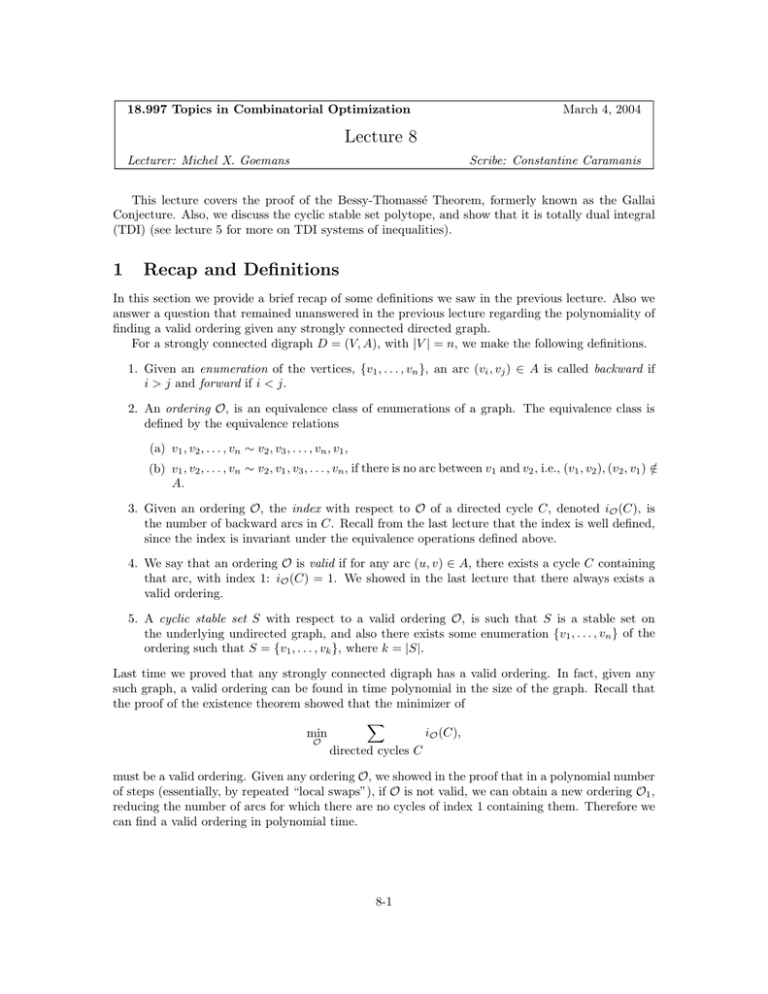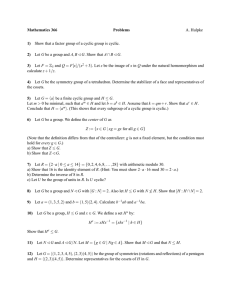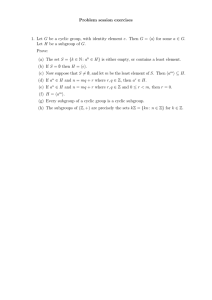Lecture 8
advertisement

18.997 Topics in Combinatorial Optimization
March 4, 2004
Lecture 8
Lecturer: Michel X. Goemans
Scribe: Constantine Caramanis
This lecture covers the proof of the Bessy-Thomassé Theorem, formerly known as the Gallai
Conjecture. Also, we discuss the cyclic stable set polytope, and show that it is totally dual integral
(TDI) (see lecture 5 for more on TDI systems of inequalities).
1
Recap and Definitions
In this section we provide a brief recap of some definitions we saw in the previous lecture. Also we
answer a question that remained unanswered in the previous lecture regarding the polynomiality of
finding a valid ordering given any strongly connected directed graph.
For a strongly connected digraph D = (V, A), with |V | = n, we make the following definitions.
1. Given an enumeration of the vertices, {v1 , . . . , vn }, an arc (vi , vj ) ∈ A is called backward if
i > j and forward if i < j.
2. An ordering O, is an equivalence class of enumerations of a graph. The equivalence class is
defined by the equivalence relations
(a) v1 , v2 , . . . , vn ∼ v2 , v3 , . . . , vn , v1 ,
/
(b) v1 , v2 , . . . , vn ∼ v2 , v1 , v3 , . . . , vn , if there is no arc between v1 and v2 , i.e., (v1 , v2 ), (v2 , v1 ) ∈
A.
3. Given an ordering O, the index with respect to O of a directed cycle C, denoted iO (C), is
the number of backward arcs in C. Recall from the last lecture that the index is well defined,
since the index is invariant under the equivalence operations defined above.
4. We say that an ordering O is valid if for any arc (u, v) ∈ A, there exists a cycle C containing
that arc, with index 1: iO (C) = 1. We showed in the last lecture that there always exists a
valid ordering.
5. A cyclic stable set S with respect to a valid ordering O, is such that S is a stable set on
the underlying undirected graph, and also there exists some enumeration {v1 , . . . , vn } of the
ordering such that S = {v1 , . . . , vk }, where k = |S|.
Last time we proved that any strongly connected digraph has a valid ordering. In fact, given any
such graph, a valid ordering can be found in time polynomial in the size of the graph. Recall that
the proof of the existence theorem showed that the minimizer of
�
iO (C),
min
O
directed cycles C
must be a valid ordering. Given any ordering O, we showed in the proof that in a polynomial number
of steps (essentially, by repeated “local swaps”), if O is not valid, we can obtain a new ordering O1 ,
reducing the number of arcs for which there are no cycles of index 1 containing them. Therefore we
can find a valid ordering in polynomial time.
8-1
2
The Bessy-Thomassé Theorem
Recall the statement of the theorem.
Theorem 1 Given a strongly connected digraph D = (V, A), and a valid ordering O, if αO denotes
the size of the largest cardinality cyclic stable set, then
�
αO = min
iO (Ci ),
{C1 ,...,Cp }
where the cycles {C1 , . . . , Cp } cover the vertex set V .
The inequality
αO ≤ min
�
iO (Ci ),
{C1 ,...,Cp }
is straightforward (as each vertex of a cycle stable set must be contained in (at least) one directed
cycle and the corresponding entering arc must be backward), so we consider only the proof of the
reverse inequality.
Before we prove this theorem, we make some remarks. It is important to note that the cyclic
stability number, αO , depends on the ordering O chosen. To illustrate this, recall our digraph on five
vertices from last lecture. In Figure 2, we exhibit two different orderings where the cyclic stability
number is different.
��
��
��
��
��
��
��
��
�
�
��
��
�
�
��
��
Figure 1: In figure (a) above, the cyclic stability number equals 2, where as in (b), the cyclic stability
number equals 1.
Computing the stability number of a general graph is known to be N P -hard. One of the corollaries of the Bessy-Thomassé Theorem is that the cyclic stability�
number can be computed efficiently.
This follows because we can can compute the quantity min {C1 ,...,Cp } iO (Ci ) in the right hand
side of the theorem above, efficiently. We can do this by formulating a network flow problem that
computes the minimization. To do this, fix an enumeration of the ordering. Attach a cost of 0 to
every forward arc in the digraph under the given enumeration, and a cost of 1 to every backward arc.
Next, split each vertex v into a pair {vout , vin } with a directed edge (vout , vin ) with flow capacity
bounded from below by 1. Then for every arc (u, v) in the original graph, draw an arc (uout , vin ) in
the network flow graph. Finding a minimum cost flow in this network can be �
done efficiently, and
it amounts to finding a set of cycles {C1 , . . . , Cp } that cover V , and minimize {C1 ,...,Cp } iO (Ci ).
A key step in the proof of the Bessy-Thomassé Theorem is a lemma that provides a sufficient
condition for a subset S of vertices to be a cyclic stable set.
8-2
Lemma 2 Given a valid ordering O, fix an enumeration, {v1 , . . . , vn }. Let S ⊆ V be a subset of
the vertices. If there are no forward paths between any two vertices of S, then S is a cyclic stable
set.
Proof: Suppose, to the contrary, that S has no forward arcs, but S is not a cyclic stable. Let vi
be the first element of the enumeration in S. If we rotate the enumeration so that vi becomes v1 ,
no forward paths are either created or destroyed in S, so we may assume, without loss of generality,
that v1 ∈ S. If S is a cyclic stable set with respect to O, then there exists some enumeration of O
for which the elements of S are the first k = |S| elements of the enumeration. Equivalently, there
exists a sequence of local steps, or swaps we can make according to the equivalence relations defining
an ordering, to move from the current enumeration to one of the correct form. If S is not a cyclic
stable set, as we assume, then this is not possible. Consider the enumeration which brings S “as
close as possible” to having all its elements at the beginning of the enumeration, as illustrated in
Figure 2. By this we mean that as many elements of S as possible are listed first in the enumeration,
and furthermore, the first element of S not part of the initial string of elements of S (which we call
S< ) is as close to S< as possible. We denote by S< the elements of S that are at the beginning of
�
�
� �
�
��
�
�
�
�
��
��
�
�
�
��
Figure 2: The figure exhibits the enumeration with respect to which as many elements of S as possible are
the first elements of the enumeration. Since S is assumed not to be a cyclic stable set, there must be some
element w sandwiched by elements of S.
the enumeration, by S> the remaining elements of S, and by W the elements after the last element
of S< and before the first element of S> , as illustrated in Figure 2. Since there are no forward
paths joining any two elements of S, for any w ∈ W there cannot be a forward path from S< to
w, and a forward path from w to an element of S> . Consider the first w ∈ W where there is no
forward path from S< to w (if there is such a vertex). Because w is assumed to be the first such
vertex, there can be no forward path from any vertex v coming before w in the enumeration. If
there were such a vertex v, then if there were a forward path from S< to v, we would also have a
forward path from S< to w. If there were no forward path from S< to v, it would contradict our
assumption that w is the first vertex in W that has no forward path from S< . In particular, then,
there are no arcs from any vertex before w in the enumeration, to w. However, there also can be
no arc from w to any vertex before it in the enumeration. This follows because O was assumed to
be a valid ordering. If there were such an arc, say (w, v) for v earlier in the enumeration, because
we assume there are no forward arcs from any vertex coming before w, to w, and that w is the first
such vertex, then any cycle C containing the arc (w, v) must have iO (C) ≥ 2, a contradiction to the
validity of the ordering O. Therefore there are no arcs between w and any vertex previous to w in
the enumeration. But then using the equivalence relations, we can swap w with each element before
it, including then each element of S< . But this contradicts our assumption that the first element of
8-3
S \ S< was as close as possible to S< . Therefore there are no elements in W that have no forward
paths from S. In particular, this implies that there are no forward paths from any w ∈ W to S> .
Then, let vj ∈ S be the first vertex in S> . By assumption, unless W is empty, vj−1 ∈ W , and there
is no forward path from vj−1 to S> , and in particular, (vj−1 , vj ) ∈
/ A. But then, since O is a valid
ordering, (vj , vj−1 ) ∈
/ A. In this case, we can swap the two vertices, contradicting our assumption
that our enumeration put S “as close as possible” to having its elements at the beginning of the
enumeration. Therefore W must be empty, and S is indeed a cyclic stable set.
�
We now move to the proof of the Bessy-Thomassé Theorem.
Proof:
The Main Idea: We want to show that the size of the maximum cyclic stable set equals the minimum
total index of a family of cycles covering V . Essentially the proof relies on mapping our digraph D
to a poset T . At this point, we appeal to Dilworth’s Theorem (lecture 6). Recall that the strong
version of Dilworth’s Theorem tells us that the size of the largest antichain in the poset equals
the minimum number of chains needed to partition the elements of the poset. We show that our
maximum size cyclic stable set S in D, corresponds naturally to an antichain in the poset T . Thus
the size of the largest antichain in T is at least the size of S, i.e., αO . Then we use Lemma 2 to
show that any antichain in T corresponds to a cyclic stable set in D. Thus we have that the size of
the largest antichain in T is exactly αO .
Dilworth’s Theorem now links the number of chains partitioning T to αO . The final part of the
proof recovers a covering family of cycles from the chains in T .
The Proof: For the given ordering O, let S = {v1 , . . . , vk } denote the maximum size cyclic stable set, with corresponding enumeration of V = {v1 , . . . , vk , . . . , vn }. We note that since S is, in
particular, a stable set, we can permute its elements as we wish within the given ordering.
We form an acyclic digraph D = (V , A ) from D as follows. Let V = {v1 , . . . , vn , v1 , . . . , vk }
(we duplicate the elements of S) so that |V | = n + k. Next, if (v, w) ∈ A is a forward arc, then
(v, w) ∈ A . If (w, vi ) ∈ A is a backward arc into a vertex of S (i.e., if vi ∈ S) then (w, vi ) ∈ A .
Note that by our choice of enumeration, any arcs into vi , i ≤ k, must be backward. Therefore the
digraph D is acyclic. It is illustrated in Figure 2.
�
�
�
��
��
���
��
��
��
���
��
� � � � � �
�
�
�
Figure 3: This figure illustrates the directed acyclic graph D� we obtain from splitting the vertices in S and
drawing arcs as explained above.
In order to use Dilworth’s Theorem, we need to have a poset T . We obtain a poset T from
the acyclic digraph D by considering the transitive closure of D . Since the sets {v1 , . . . , vk } and
8-4
{v1 , . . . , vk } have no incoming and outgoing arcs, respectively, they are both antichains in T . This
is also evident from Figure 2. We show that they are in fact maximum size antichains. Consider any
antichain I. As the ordering is valid, for any vertex, there exists a directed cycle of index 1 going
through it. This translates into a chain in the poset going from vi to vi for any 1 ≤ i ≤ k. This
means that an antichain I cannot contain both vi and vi . Let ID be the elements of the original
digraph D corresponding to I.
By renumbering the elements of S (recall that we can permute the elements of S within the
, . . . , vk ∈
/ I. Now rotate the enumeration
given ordering) we can assume that v1 , . . . , vl ∈ I, and vl+1
to obtain {v˜1 , . . . , v˜n } so that v˜1 = vl+1 . Since I is an antichain, and since the digraph vertices
{v1 , . . . , vl } corresponding to the poset elements {v1 , . . . , vl } at the “top” of the poset T have been
rotated to be the last elements of the enumeration, there are no forward paths between any two
elements of ID . Therefore, by Lemma 2, ID is a cyclic stable set. Therefore ID , and consequently
I, can have size at most equal to the size of S, that is, αO . We have thus shown that the size of the
largest antichain in T is equal to the cyclic stability number αO of D.
Now consider the minimal partitioning set of chains in the poset T , call these P1 , . . . , Pk (where
k = |S| = αO ). Each chain Pi is a chain from vi to vσ(i)
, for some permutation σ of {1, . . . , k}. By
a slight abuse of notation, we also use Pi to refer to the directed path in D from vi to vσ(i) (or cycle
if σ(i) = i). We note that by construction of T , there is exactly one backward arc in each path Pi ,
namely, the last arc to vσ(i) . These paths cover the vertex set V . Now, the cycles in the permutation
σ correspond to cycles in D. For example, if (12) is a cycle in σ, i.e., if σ(1) = 2 and σ(2) = 1,
then joining the paths P1 and P2 we have a cycle from v1 to v1 . We note that these cycles may in
fact intersect. Since the cycles merely need to cover the vertex set V , distinct cycles can intersect.
We need to take care that the same cycle does not intersect itself. If σ happens to be the identity
permutation, σ(i) = i, then each path is a cycle and cannot intersect itself, and hence the proof is
complete. If this is not the case, then a cycle in D obtained by joining together the paths Pi that
correspond to a cycle of σ may in fact intersect itself. Suppose that i and j are in the same cycle
of σ and the paths Pi and Pj intersect, in say v. We can then replace the paths Pi and Pj by two
other paths Pi and Pj (obtained by switching from one to the other at v) which together cover the
same vertices and which corresponds to a new permutation σ with σ (i) = σ(j) and σ (j) = σ(i).
Now the number of cycles in the permutation has increased by one, and we can repeat this process
until no cycle in D (corresponding to each cycle of teh permutation σ) intersects itself.
Since the cycle splitting procedure does not change the total index of the cycles, we know that
the total index equals the minimal number of chains required to partition T . But by above, this is
exactly the size of the maximum cyclic stable set, and therefore
�
iO (Ci ),
αO = min
{C1 ,...,Cp }
�
which is what we wanted to prove.
3
Cyclic Stable Set Polytope
In this section, we follow some recent (unpublished) work of A. Sebö, and define the cyclic stable
set polytope of a strongly connected graph D, with a given valid ordering O. Define the polytope
P as follows.
� �
�
� x(C) ≤ iO (C), ∀ directed cycles C
.
P = x�
xv ≥ 0,
∀v ∈ V
We show in this section that the polytope P is totally dual integral (TDI) (see lecture 5 for more
on TDI system of inequalities).
Given a cyclic stable set S (cyclic stable with respect to the given ordering), let xS denote its
incidence vector, i.e., xSv = 1 if v ∈ S, and 0 otherwise. Then in fact xS ∈ P. Indeed, consider any
8-5
directed cycle C. Since S is cyclic stable, C always enters S via a backward arc, and therefore the
number of backward arcs of C is at least the cardinality of its intersection with S:
(# backward arcs in C) = iO (C) ≥ |C ∩ S|,
or, equivalently, xS (C) ≤ iO (C).
Since we have shown that the incidence vector of every cyclic stable set belongs to P, we have:
�
αO ≤ max :
v∈V xv
s.t. : x(C) ≤ iO (C), ∀C
xv ≥ 0, ∀v ∈ V
By linear programming duality, and then by observing that the optimum value of a minimization
can only increase if we add constraints, we have
�
αO ≤ max :
v∈V xv
s.t. : x(C) ≤ iO (C), ∀C
xv ≥ 0, ∀v ∈ V
=
≤
min :
s.t. :
min :
s.t. :
�
�C iO (C)yC
C : v∈C yC ≥ 1,
yC ≥ 0, ∀C
∀v ∈ V
�
�C iO (C)yC
C : v∈C yC ≥ 1,
yC ≥ 0, ∀C
yC ∈ {0, 1}.
∀v ∈ V
But this last quantity is exactly the minimum total index of a cycle cover of V , and thus by the
Bessy-Thomassé Theorem, the final quantity equals αO . Therefore equality must hold throughout.
Recall that in order to prove that the description of P is TDI, we must show that for all integral
objective functions w (wv ∈ Z), the dual linear program
�
min : �C iO (C)yC
s.t. :
∀v ∈ V
C : v∈C yC ≥ 1,
yC ≥ 0, ∀C
has an integral solution whenever its value is finite. We note that we have just proved this statement
for the special case wv = 1. We note also that if we have wv ≤ 0, we can replace this wv by 0
without affecting the feasible region of the dual linear program. Therefore, we can assume that we
have wv ∈ Z+ .
We now construct a strongly connected digraph D = (V , A ), with valid ordering O as follows.
Let V consist of wv copies of each xv , {xv,1 , . . . , xv,wv } (recall that wv is a positive integer). If
(v, u) ∈ A, then (xv,i , xu,j ) ∈ A for every i ≤ wv and j ≤ wu . From our reasoning above, we
know that the linear program associated to the digraph D (now we have wv = 1 for every v ∈ V )
produces an integral solution that corresponds to a maximum size cyclic stable set in D . Note that
if xv,i is in the stable set S for D , then we can also take xv,j to be in S for any j ≤ wv . Therefore
any maximum size cyclic stable set S in D naturally corresponds to a cyclic stable set S in D.
Moreover, |S | = w xS . Conversely, if S is a cyclic stable set in D, then the set S of all copies of
the vertices in S, is a cyclic stable set in D , with |S | = w xS . Therefore given any vector w with
wv ∈ Z+ , the linear program with objective function w x has an integral optimal solution. Therefore
P is totally dual integral, as we wished to show.
8-6




